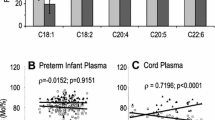Abstract
The phospholipid molecular species from a large-scale preparation of human placenta lipids were analyzed. The major placental phospholipids were choline glycerophospholipids (CPL) (53.2 wt%), sphingomyelin (21.7 wt%) and ethanolamine glycerophospholipids (EPL) (14.6 wt%). 1,2-Diacyl-glycerophosphocholine was the most abundant subclass of CPL (91.7 mol%), while EPL contained 1,2-diacyl (54.6 mol%) and 1-alk-1′-enyl-2-acyl (43.8 mol%) subclasses. The level of polyunsaturated fatty acids (PUFA) in total phospholipids was remarkably constant (38.4–39.9 mol%) within all placental batches tested. The long-chain PUFA, mainly 20∶4n−6 and 22∶6n−3 of the n−6 and n−3 series, respectively, were found in high proportion in all phospholipid classes, especially in EPL (46.7 mol%) and in inositol glycerophospholipids (IPL) (39.9 mol%). CPL and serine glycerophospholipids were much richer in 18∶1n−9 and 18∶2n−6. High levels of molecular species with arachidonic acid in thesn-2 position were found particularly in 1-alk-1′-enyl-2-acyl-glycerophospho-ethanolamine (with 24.0 mol% 16∶0 and 22.0 mol% 18∶0 insn-1 position) and in 1,2-diacyl glycerophosphoinositol with 42.6 mol% 18∶0 insn-1 position. EPL subclasses were rich in 22∶6n−3, which occurs mainly as 16∶0/22∶6n−3 (11.7 mol%) in the polasmalogen form and as 18∶0/22∶6n−3, 16∶0/22∶6n−3 and 18∶1/22∶6n−3 in the diacyl forms. Based on their availability and composition, placental phospholipids could be of interest, for example, for supplementing artificial milk preparations with n−3 and n−6 long-chain PUFA for newborn infants with insufficiently developed 18∶2n−6 and 18∶3n−3 desaturation/elongation.
Similar content being viewed by others

Abbreviations
- BHT:
-
butylated hydroxytoluene
- CPL:
-
choline glycerophospholipids
- EPL:
-
ethanolamine glycerophospholipids
- GLC:
-
gas-liquid chromatography
- GPC:
-
glycerophosphocholines
- GPE:
-
glycerophosphoethanolamines
- GPI:
-
glycerophosphoinositols
- GPS:
-
glycerophosphoserines
- HPLC:
-
high-performance liquid chromatography
- IPL:
-
inositol glycerophospholipids
- PUFA:
-
polyunsaturated fatty acids
- SPL:
-
serine glycerophospholipids
- TLC:
-
thinlayer chromatography
References
Sinclair, H. (1990)Biochem. Soc. Trans. 18, 756–761.
Burr, G.O., and Burr, M.M. (1930)J. Biol. Chem. 86, 587–621.
Holman, R.T. (1968)Prog. Chem. Fats Lipids 9, 275–348.
Kinsella, J.E. (1991)Adv. Food Nutr. Res. 35, 1–184.
Bazan, N.G. (1990) inNutrition and the Brain (Wurtman, R.J., and Wurtman, J.J., eds.) Vol. 8, pp. 1–24, Raven Press, New York.
Fliesler, S.J., and Anderson, R.E. (1983)Prog. Lipid Res. 22, 79–131.
O'Brien, J.S., and Sampson, E.L. (1965)J. Lipid Res. 22, 545–551.
Neuringer, M., Connor, W., Lin, D., Barsted, L., and Luck, S. (1986)Proc. Natl. Acad. Sci. USA 83, 4021–4025.
Clandinin, M.T., Chappell, J.E., Leong, S., Heim, T., Swyer, P.R., and Chance, G.W. (1980)Early Hum Dev. 4, 131–138.
Uauy, R.D., Birch, D.G., Birch, E.E., Tyson, J.E., and Hoffman, D.R. (1990)Pediatr. Res. 28, 485–492.
Gibson, R.A., and Kneebone, G.M. (1981)Amer. J. Clin. Nutr. 34, 252–257.
Uauy, R., Treen, M., and Hoffman, D.R. (1989)Seminars in Perinatology 13, 118–130.
Kolarovic, L., and Fournier, N.C. (1986)Anal. Biochem. 156, 244–250.
Hadjiagapiou, C., and Spector, A.A. (1987)Arch. Biochem. Biophys. 253, 1–12.
Juanéda, P., Rocquelin, G., and Astorg, P.O. (1990)Lipids 25, 756–759.
Takamura, H., Narita, H., Urade, R., and Kito, M. (1986)Lipids 21, 356–361.
Croset, M., Bayon, Y., and Lagarde, M. (1992)Biochem. J. 281, 309–316.
Patton, G.M., Fasulo, J.M., and Robins, S.J. (1982)J. Lipid. Res. 23, 190–196.
Patton, G.M. (1990)J. Nutr. Biochem. 1, 548–556.
Morrison, W.R., and Smith, L.M. (1964)J. Lipid Res. 5, 600–608.
Chirouze, V., Entressangles, B., and Helme, J.P. (1987)Rev. Franç. Corps Gras 34, 275–280.
Robertson, A.F., and Sprecher, H. (1968)Acta Pediatr. Scand. 183, 1–18.
Nelson, G. (1971)Amer. J. Obstret. Gynec. 110, 352–354.
Percy, P., Vibergsson, G., Percy, A., Mansson, J.E., Wenergren, M., and Svennerholm, L. (1991)Biochim. Biophys. Acta 1084, 173–177.
MacDonald, J.I.S., and Sprecher, H. (1991)Biochim. Biophys. Acta 1084, 105–121.
Takamura, H., Kasai, H., Arita, H., and Kito, M. (1990)J. Lipid Res. 31, 709–717.
Author information
Authors and Affiliations
About this article
Cite this article
Bayon, Y., Croset, M., Chirouze, V. et al. Phospholipid molecular species from human placenta lipids. Lipids 28, 631–636 (1993). https://doi.org/10.1007/BF02536058
Received:
Revised:
Accepted:
Issue Date:
DOI: https://doi.org/10.1007/BF02536058



